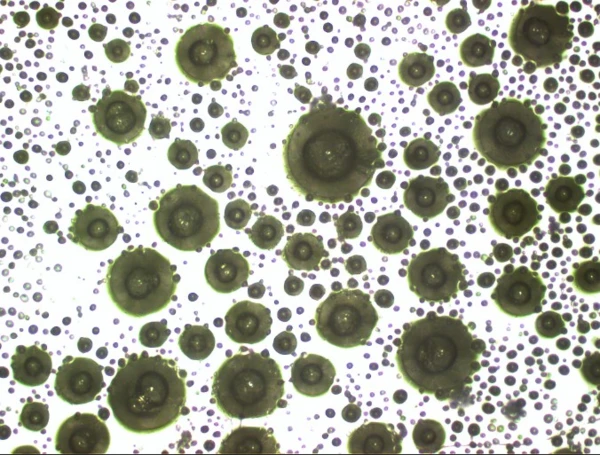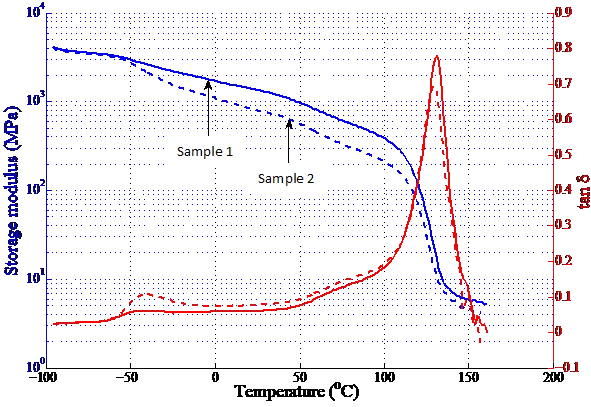
20.10.2020 by Tatiana Stefanov, University of Dublin
Investigating phase separation in elastomer-toughened adhesives with DMA
Many of the polymers that are used in adhesives are relatively brittle materials. To improve their toughness, different fillers or toughening agents are incorporated in the adhesive formulations. Phase separation occurs during the process of monomer conversion to polymer. An understanding of the phase separation behavior under different Curing (Crosslinking Reactions)Literally translated, the term “crosslinking“ means “cross networking”. In the chemical context, it is used for reactions in which molecules are linked together by introducing covalent bonds and forming three-dimensional networks.curing conditions and the development of the morphology are important. This editorial summarizes the application of the DMA in the investigation of thermal properties and phase separation in elastomer-toughened ethyl cyanoacrylate adhesive bulk films.
A wide range of adhesives exists on the market today, including epoxies, silicones, polyurethanes, cyanoacrylates, anaerobics and so on, with applications in the automotive, construction, aircraft, electronic and medical device industries, in addition to surgical and general purpose domestic applications. The use of adhesives in load-bearing applications requires resistance to crack initiation and growth, that is, toughness. Many of the polymers that are used in adhesives are relatively brittle materials. To improve their toughness, different fillers or toughening agents are incorporated in the adhesive formulations.
Phase separation occurs during the process of monomer conversion to polymer, i.e., polymerization or Curing (Crosslinking Reactions)Literally translated, the term “crosslinking“ means “cross networking”. In the chemical context, it is used for reactions in which molecules are linked together by introducing covalent bonds and forming three-dimensional networks.curing, of the toughened adhesive. An understanding of the phase separation behavior under different Curing (Crosslinking Reactions)Literally translated, the term “crosslinking“ means “cross networking”. In the chemical context, it is used for reactions in which molecules are linked together by introducing covalent bonds and forming three-dimensional networks.curing conditions and the development of the morphology are important steps towards identifying the mechanism of phase separation. Dynamic mechanical analysis (DMA) is a versatile technique for characterizing various polymer blends, and therefore toughened adhesives. Different testing modes are available depending on the application or sample material.
This editorial summarizes the application of the NETZSCH DMA 242 E Artemis in the investigation of thermal properties and phase separation in elastomer-toughened ethyl cyanoacrylate adhesive bulk films, which was published in detail in the International Journal of Adhesion and Adhesives in 2020 [1]. Bulk films were cured at room temperature, both with and without premixed initiators, between poly (ethylene) (PE) substrates and in a poly (tetrafluoroethylene) (PTFE) mold.
Toughening of cyanoacrylate (CA) adhesives

Cyanoacrylate (CA) adhesives are unique among the many classes of adhesives due to their fast Curing (Crosslinking Reactions)Literally translated, the term “crosslinking“ means “cross networking”. In the chemical context, it is used for reactions in which molecules are linked together by introducing covalent bonds and forming three-dimensional networks.curing speed at room temperature and high strength in confined bonds. Therefore, the toughening of these adhesive systems would be a great advantage.
Transitions in polymers can be measured by monitoring the change in storage modulus, Viscous modulusThe complex modulus (viscous component), loss modulus, or G’’, is the “imaginary” part of the samples the overall complex modulus. This viscous component indicates the liquid like, or out of phase, response of the sample being measurement. loss modulus, or the loss factor during a DMA temperature scan. These changes depend on the RelaxationWhen a constant strain is applied to a rubber compound, the force necessary to maintain that strain is not constant but decreases with time; this behavior is known as stress relaxation. The process responsible for stress relaxation can be physical or chemical, and under normal conditions, both will occur at the same time. relaxation behavior of the polymer chains. One of the most important transitions in polymers is the Glass Transition TemperatureThe glass transition is one of the most important properties of amorphous and semi-crystalline materials, e.g., inorganic glasses, amorphous metals, polymers, pharmaceuticals and food ingredients, etc., and describes the temperature region where the mechanical properties of the materials change from hard and brittle to more soft, deformable or rubbery.glass transition temperature (Tg), which is indicated by the sharp decrease in the storage modulus signal. At this temperature, the Viscous modulusThe complex modulus (viscous component), loss modulus, or G’’, is the “imaginary” part of the samples the overall complex modulus. This viscous component indicates the liquid like, or out of phase, response of the sample being measurement. loss modulus and the loss factor signals display a peak. The temperature at which the peak value of the loss factor (tan δ) signal occurred was chosen as the Glass Transition TemperatureThe glass transition is one of the most important properties of amorphous and semi-crystalline materials, e.g., inorganic glasses, amorphous metals, polymers, pharmaceuticals and food ingredients, etc., and describes the temperature region where the mechanical properties of the materials change from hard and brittle to more soft, deformable or rubbery.glass transition temperature.
While materials can be used above, below, and within the Glass Transition TemperatureThe glass transition is one of the most important properties of amorphous and semi-crystalline materials, e.g., inorganic glasses, amorphous metals, polymers, pharmaceuticals and food ingredients, etc., and describes the temperature region where the mechanical properties of the materials change from hard and brittle to more soft, deformable or rubbery.glass transition region, adhesives tend to be used below because the stiffness goes down, which means that an adhesive joint will no longer be functional.
The mixture of ethyl cyanoacrylate and elastomer will phase-separate upon cure of the cyanoacrylate monomer. The increase in the cyanoacrylate molecular weight induces phase separation. If complete phase separation of the elastomer occurs, two Glass Transition TemperatureThe glass transition is one of the most important properties of amorphous and semi-crystalline materials, e.g., inorganic glasses, amorphous metals, polymers, pharmaceuticals and food ingredients, etc., and describes the temperature region where the mechanical properties of the materials change from hard and brittle to more soft, deformable or rubbery.glass transition temperatures should be seen in the DMA curve, i.e., the Tg of the phase-separated elastomer and the Tg of the cyanoacrylate polymer.
Three regions were identified in the DMA curves as shown in Figure 2, i.e., at low temperature between -55°C and 0°C, a shoulder between 50°C and 110°C, and another region between 110°C and 160°C.
The existence of the change in storage modulus and loss factor between -55°C and 0°C, which matches the Glass Transition TemperatureThe glass transition is one of the most important properties of amorphous and semi-crystalline materials, e.g., inorganic glasses, amorphous metals, polymers, pharmaceuticals and food ingredients, etc., and describes the temperature region where the mechanical properties of the materials change from hard and brittle to more soft, deformable or rubbery.glass transition region of the elastomer (separate DMA scan of the elastomer used as a toughening agent1), confirms that the elastomer phase-separated during polymerization. The intensity of the tan δ peak shows the amount of the phase-separated elastomer. The region between 110°C and 160°C is the Tg region of the poly CA.

The shoulder between 50°C and 110°C has about the same intensity for both samples. It is thought that this region is a mixture of cyanoacrylate monomer and elastomer. The phase separation of the elastomer ceases at the time the viscosity begins to rise rapidly. Thus, at the temperature of gelation, i.e., the transition of a material from a liquid to a solid phase, the phase separation stops and locks the morphology in place. To identify the origin of the region between 50°C and 110°C, a sample of bulk film was heated to 110°C, which is considered the upper limit of the region, followed by a second heating past the Tg of the poly CA. After the 2nd heating step, the tan δ curve corresponding to the 50°C and 110°C region, leveled off and an increase in the elastomer tan δ peak together with an increase in the storage modulus was observed. This result indicates that to obtain a complete phase separation of the elastomer, a thermal treatment which consists of one step heating to 110°C could be applied.
Similar results were obtained for the bulk films cured using initiators. However, the use of initiators affected the phase separation behavior of the elastomer.
„DMA is a great technique to investigate phase separation in toughened adhesives or polymer blends. In addition to determining thermal transitions, DMA offers the advantage of monitoring the variation in mechanical properties with temperature, all in one scan.“
Source
[1] Tatiana Ștefanov, Bernard Ryan, Alojz Ivanković, Neal Murphy. (2020). Dynamic mechanical analysis of Carbon BlackTemperature and atmosphere (purge gas) affect the mass change results. By changing the atmosphere from, e.g., nitrogen to air during the TGA measurement, separation and quantification of additives, e.g., carbon black, and the bulk polymer can become possible.carbon black filled, elastomer-toughened ethyl cyanoacrylate adhesive bulk films. International Journal of Adhesion and Adhesives, 101:102630. https://doi.org/10.1016/j.ijadhadh.2020.102630.